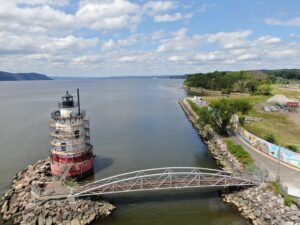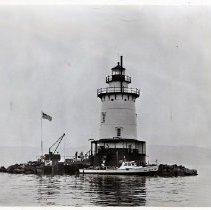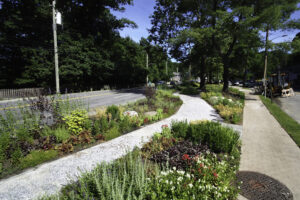
On July 1, 2022, the Village of Sleepy Hollow announced that the Sleepy Hollow Lighthouse located in Kingsland Point Park will undergo renovations as part of Westchester’s $3.2 billion dollar capital project.
Specifically, “Work consists of repairs and repainting to the exterior cast iron, replacement of windows and impact doors, repair of cracks in the cellar, cleaning and re-pointing of the foundation masonry, restoration of the interior painting & plaster finishes throughout and repairs to and restoration of all the wood floors. The work will also include reconstruction of the intermediate landing between the bridge and gangway, a new security gate on the mainland and new electric and exterior lighting,” stated the Village
Mace Contracting Corp, located in New Rochelle, is doing the renovations. Having started on July Fourth weekend, the improvements are projected to take a year—and residents can’t wait for them to be complete.
“This project is long overdue and, in my mind, well worth the cost. The Lighthouse is a historical landmark and should be persevered,” shared Anthony Giaccio, the Village Manager of Sleepy Hollow.
The History of the Sleepy Hollow Lighthouse

“If you don’t take care of your past, there is no sense for the future,” shared Barbara Davis, Co-Director of the Westchester County Historical Society.
The Sleepy Hollow Lighthouse served the Hudson River for 78 years, operating from 1883-1961. What makes this lighthouse especially significant is that it was occupied by several families. There were three civilian keepers, the first being Joseph Ackerman. Ackerman, who was considered the President of the Town of North Tarrytown (later renamed Tarrytown), was there for 21 years with his wife, children, two dogs, several cats, and a flock of chickens. The next family keeper was Lauret Leclerc, who operated the lighthouse from 1941-1954. Tragically, his son died in the river in 1947. The last father to occupy the tower was Richard Moreland. He lived there with his wife and two daughters from 1955 to 1958. Edward Murrow, the host of a popular television program called “Person to Person”, interviewed Moreland and his family to learn about their experience.
Unearthing these keepers’ stories is crucial to understanding the culture of their work and appreciating all the history attached to their home. Remarkably, most of the family’s stories come from first-hand accounts.
In the National Archives, they have preserved cursive written logs that each keeper recorded in during their stay. These journals detail their daily responsibilities, such as getting up every few hours to set the clock and ring the bell, and make sure that there was enough kerosene to power the light. If the bell ever broke, the keeper would have to ring it by hand all throughout the night.
In terms of monitoring the waters, the keepers cited weather conditions, such as storms and hurricanes, and recounted incidents of saving canoers from drowning and boaters from colliding. In many cases, they would see vessels get caught in riptides or the Hudson’s choppy waters and have to call for a rescue.

In addition to gaining valuable insight into the lives of the keepers, the logs also included discussion of national events such as the attack on Pearl Harbor and any U.S. declared wars. “It wasn’t only their personal accounts of what they were doing with the lighthouse, [but] they also sort of give you an account of what was going on in the world,” Davis shared.
The Journey to Renovations
When the lighthouse was decommissioned after the Tappan Zee Bridge was completed in 1967, the government offered it to Westchester County. Initially, the Board of Supervisors passed because the repairs totaled $50,000, which was more than they wanted to spend. However, it took only one compelling speech delivered by a board member, focusing on its novelty, to convince the body to invest in the lighthouse. In 1974, the county acquired it for one dollar.
In the 1980’s, the land the lighthouse sits on, Kingsland Point Park, was landmarked as a National Register of Historic Places property. This didn’t give the lighthouse any protection “unless something is going to impact it that involves state or federal money. But it does always serve as a red flag that this is an important piece of our history that needs preservation and needs protection,” Davis explained.
At this time, the county also started working with the Hudson River Foundation leading tours throughout the lighthouse. These tours continued until it closed in July for renovations, and highlighted the small quarters, cramped furniture, and tucked appliances. Along with the set-up, there were also maps of the river and pictures from the lighthouses’ functional years. One noteworthy image that was featured in the tour showed the Hindenburg flying over the structure in 1937.
In the early 2000’s, the county entered a municipal agreement with the Village of Sleepy Hollow, giving them oversight of Kingsland Point Park and the lighthouse. Over the last ten years, the village has been working to advance renovations. In 2011, county legislators approved several designs for the lighthouse.
In 2013, $800,000 was allocated to complete the project. Unfortunately, the lowest bids from contractors were estimated at over $1 million, so the project was scrapped.
Since then, the only repair that took place was in 2015, which was the installation of a new light lens. “It really was when County Executive George Latimer came on board a few years ago, where he really pushed the over $3 million bond to get this and other Westchester landmarks fixed up as well,” shared Matthew Arone, the Superintendent of Parks & Recreation for the Village of Sleepy Hollow.
Another factor that seems to have furthered the project’s advancement is the development of the Edge-on-Hudson Property that overlooks the tower. With over 1,000 townhomes, condominiums, and apartments, “we can’t have them all looking out their window, seeing a dilapidated lighthouse. So that project really helped put a little more pressure on everybody…[to] get the view out of our window to look beautiful again,” Arone stated.
With the money and the motivation, the restoration project moved forward. Since the initial announcement made in July, notable progress has been made on the lighthouse.
As of August 12, the scaffolding is up. The wood floors and ceilings have been removed. Within a month they will start work on a Coffer Dam which goes around the lighthouse so that they can redo the foundation, and the entire project should take at least a year to complete.
The Future of the Lighthouse
With renovations underway, Arone has big hopes for how the lighthouse can make an impact on the community. “I’m excited for the renovations as the Recreation Superintendent, because I know this is going to open up many more opportunities for us as a village to do programming there, open houses there, and trips there,” Arone explained.
Specifically, Arone envisions guided tours with the Sleepy Hollow Historical Society, class trips, arts and crafts projects like lighthouse sketching, and access to inside and top viewings.
“Not many people have had lighthouses before in their parks department, so once it’s up and running and looking good, we’re definitely going to try to think of some fun new things for people to do,” Arone stated.
While this programming is a gift to the community, it also serves to preserve and celebrate the lighthouse’s history.
“The more we get people on to the Hudson, whether it’s in the lighthouse or off a boat or in a kayak, there is a greater appreciation for [the lighthouse], which leads to greater protection. And to get people into the lighthouse to understand more of our history…is quite extraordinary,” Davis shared.
As more community members become aware of this invaluable local landmark, the greater the chances that the lighthouse will never again be in disrepair.
“[The lighthouse] has such value in so many ways of telling the story of the Hudson River. The building of the Tappan Zee Bridge, the development of Westchester County, the importance of river traffic, [and] the kind of lives people lived in service for their country…. These are all part of our history and our culture and their protection and preservation only make us a stronger and better society,” stated Davis.
To witness the progress being made on the Sleepy Hollow Lighthouse, visit the Tarrytown RiverWalk for an up-close look at the first six weeks of the renovations.







Matt Arone is correct. A heartfelt thanks for the restoration of the Sleepy Hollow Lighthouse goes to County Executive George Latimer who understands the value of our collective history.